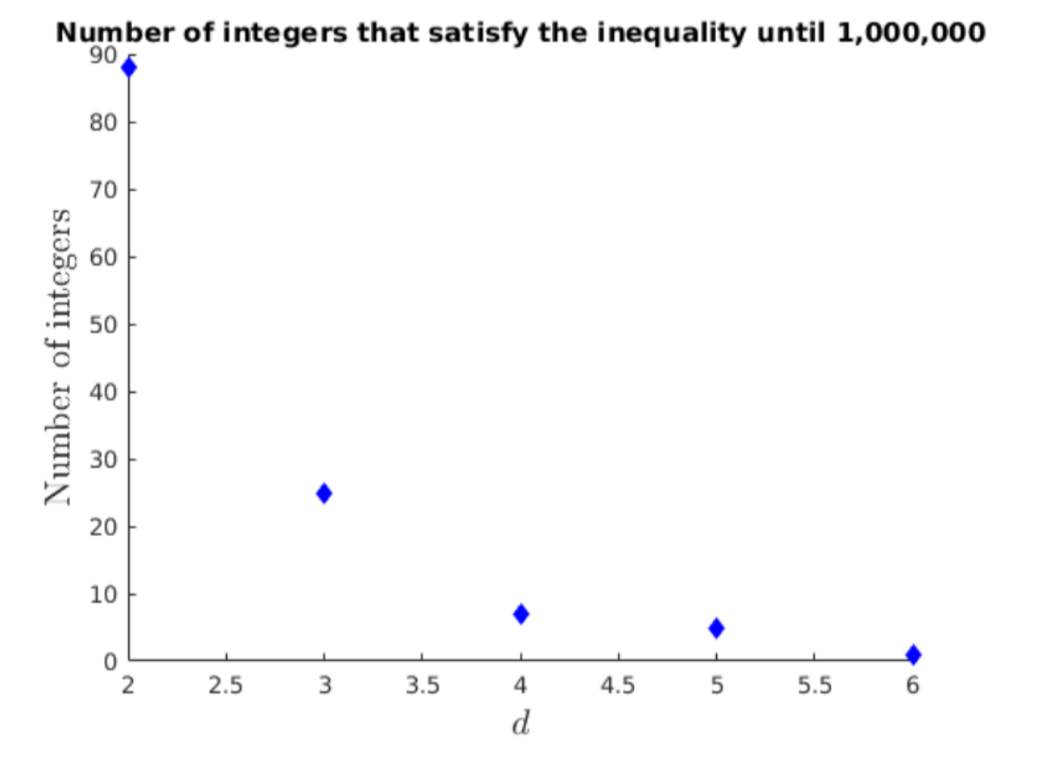LaTeX4Web 1.4 OUTPUT
First we prove another case in which n satisfies the Condition 1 defined in the section "An open problem". Let q
i be the largest prime smaller than n and let p
qaq
be any prime factor divisor of n. By checking computationally all the pairs of primes that satisfy Condition 1 for each integer, we prove the following: Theorem. If n-qi < pqaq
|
, then n satisfies Condition 1 with pq and qi. For the proof of this theorem we make use of Bertrand-Chebyshev Theorem: Theorem. (Bertrand-Chebyshev) For every integer n > 3 there exists a prime p such that n/2 < p < n. Proof: For the proof of the previous theorem we distinguish between two intervals: the interval (1, n-qi] and the interval (n-qi, n]. Due to the symmetry of binomial coefficients, we only consider k £ n/2. By the Bertrand-Chebyshev Theorem, we know that there is at least one prime between n/2 and n, hence n/2 < qi < n. Then, for all k, k < n/2 < qi. The base qi representation of n is 1 · qi + n-qi. Therefore, we do not need to consider the interval (n-qi) because the last digit of the base qi representation of any k> n-qi is larger than the last digit of the base qi representation of n and thus by Lucas¢ Theorem the binomial coefficient \binomnk is divisible by qi. If also there is no multiple of pqaq
|
in the interval (1, n-qi), then by Lucas¢ Theorem all the binomial coefficients \binomnk with 1 £ k £ n/1 are divisible by at least pq or pi. Moreover, the case of equality in the previous theorem cannot occur because pqaq
|
divides both pqaq
|
and n, and hence qi would not be a prime.
LaTeX4Web 1.4 OUTPUT
Note that for the previous theorem we do not necessarily need pqaq
|
to be the largest prime power divisor of n, and therefore we have the following corollary: Corollary. Let pjaj
|
denote the largest prime power divisor of an integer n. If n - qi < pjaj
|
, then n satisfies Condition 1 with pj and qi. Note that if n satisfies Condition 1 at least one of these two primes has to be a prime factor of n, because otherwise C(n,1) = n is not divisible by either of the two primes. Thus, the only remaining cases are those in which n - qi > pqaq
|
and n is not a prime or a prime power. By analyzing the integers that are part of these remaining cases, we notice that n usually satisfies Condition 1 with the pair formed by a prime factor of n and the largest prime smaller than n/2. Let qr denote the largest prime smaller than n/2. If we analyze the six numbers smaller than 2,000 such that n - qi > pqaq
|
, we see that the inequality pqaq
|
> n-2qr holds and qr and pq satisfy Condition 1. The following table shows the only six numbers until 2,000 that do not satisfy Condition 1 with qi and pq. However, the sequence of all such integers is infinite. The Online Encyclopedia of Integer Sequences (OEIS) has accepted our submission of this sequence with the reference A290203. Check the webpage: https://oeis.org/A290203.
LaTeX4Web 1.4 OUTPUT
Then, we can study the inequality n-qi > pqaq
|
> n-2qr. The fact that we are considering n-2qr comes from the base qr representation of n. We also computed the sequence of numbers that do not satisfy this inequality, and the OEIS has accepted our sequence with the reference A290290. Check the webpage: https://oeis.org/A290290.
Here you can find the code for computing the sequences A290203 and A290290 respectively.
LaTeX4Web 1.4 OUTPUT
In general, for any natural integer d, we can study the function n-dqd, where qd refers to the closest prime to n/d.
We consider the integers n that do not satisfy the inequality pqaq
|
> n-2p2. Up to 1,000,000 there are only 88 integers that do not satisfy pqaq
|
> n-2p2. Up to 1,000,000 there are 25 integers that do not satisfy the inequality pqaq
|
> n-3p3. Until 1,000,000, there are 7 integers that do not satisfy the inequality pqaq
|
> n-4p4, 5 integers that do not satisfy the inequality pqaq
|
> n-5p5 and only 1 integer that does not satisfy the inequality pqaq
|
> n-6p6. The following figure shows the number of integers up to 1,000,000 that do not satisfy the inequality pqaq
|
depending on d.
| 


